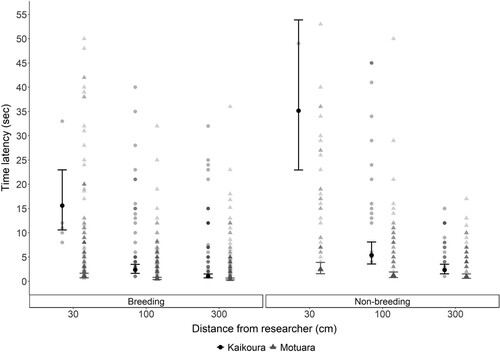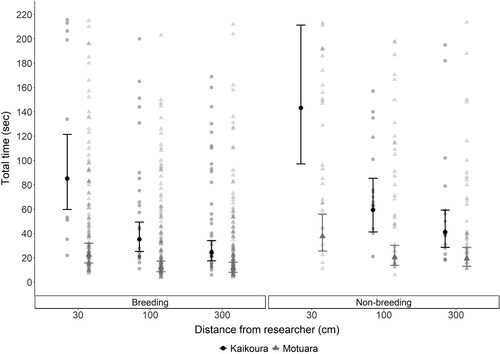Figures & data
Table 1. Likelihood of South Island robins at Kaikoura (predators present) and on Motuara Island (no introduced predators) approaching a researcher.
Figure 1. Fitted mean latency times (±SE) for South Island robins to approach and remove the first mealworm at three distances (30, 100, 300 cm) from researcher at Kaikoura (mainland site, black dots) and on Motuara Island (grey triangles) depending on the season (breeding, non-breeding season). Fitted means were back transformed from a log scale to exponential for the purpose of this figure. Raw values are also given, with darker shades indicating more overlapping values.

Figure 2. Fitted mean total time (±SE) for South Island robins to remove five mealworms, from first to last mealworm, at three distances (30, 100, 300 cm) from researcher at Kaikoura (mainland site, black dots) and on Motuara Island (grey triangles) depending on the season (breeding, non-breeding season). Fitted means were back transformed from a log scale to exponential for the purpose of this figure. Raw values are also given, with darker shades indicating more overlapping values.

Figure 3. Fitted mean handling time (±SE) for South Island robins to remove five mealworms, from first to last mealworm at three distances (30, 100, 300 cm) from researcher at Kaikoura (mainland, black dots) and on Motuara Island (grey triangles). Fitted means were back transformed from a log scale to exponential for the purpose of this figure. Raw values are also given, with darker shades indicating more overlapping values.

Table A1. List of generalised linear mixed models run predicting the likelihood of approach to retrieve mealworms (a), latency time to approach and remove the first mealworm (b), total time to remove five mealworms (c) and handling time from first to last mealworm (d) with number of birds included (n), degree of freedom (df), corrected AIC (AICc), delta AICc obtained using ‘MuMIn’ package.
Table A2. Detailed outputs of the best model predicting the likelihood of approach to retrieve mealworms (a), latency time to approach and remove the first mealworm (b), total time to remove five mealworms (c) and handling time from first to last mealworm (d) with either the mainland (Kaikoura) or Motuara Island as a reference (intercept), number of tested birds (n), AIC and R-square (R2) calculated using ‘MuMIn’ package. See for definitions of the factors.
